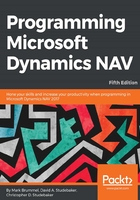
Designing a simple table
Our primary master data table will be the Radio Show table. This table lists our inventory of shows available to be scheduled.
First, open the NAV Development Environment, click on Tools | Object Designer and select Table. We can view or modify the design of existing master tables in NAV by highlighting the table (for example, Table 18 - Customer, or Table 27 - Item) and clicking on Design.
Each master table has a standard field for the primary key (a Code data type field of 20 characters called No.) and has standard information regarding the entity the master record represents (for example, Name, Address, City, and so on, for the Customer table and Description, Base Unit of Measure, Unit Cost, and so on for the Item table).
The Radio Show table will have the following field definitions (we may add more later):

In the preceding list, three of the fields are defined as Code fields, which are text fields that limit the alphanumeric characters to upper case values. Code fields are used throughout NAV for primary key values. Code fields are used to reference or be referenced by other tables (foreign keys). No. will be the unique identifier in our table. We will utilize a set of standard internal NAV functions to assign a user-defined No. series range that will auto-increment the value on table insertion and possibly allow for user entry (as long as it is unique in the table) based on a setup value. The Host No. references the standard Resource table and the Radio Show Type field will reference a custom table we will create to allow for flexible Type values.
We will have to design and define the reference properties at the field level in the Table Designer, as well as compile them, before the validation will work. At this point, let's just get started with these field definitions and create the foundation for the Radio Show table.